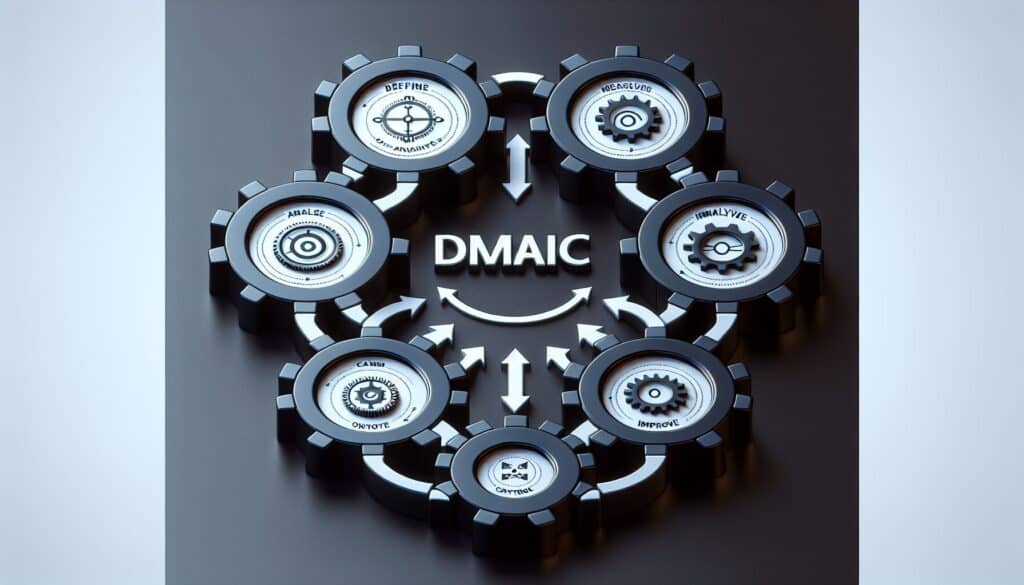DMAIC stands for “Define, Measure, Analyze, Improve and Control“, a famous data-driven, five-phase improvement cycle used in Six Sigma projects to improve existing processes by identifying and eliminating defects or problems.
- Méthodologies : Ingénierie, Qualité
DMAIC

DMAIC
- Amélioration continue, Production allégée, Techniques de résolution de problèmes, Amélioration des processus, Contrôle de qualité, Gestion de la qualité, Analyse des causes profondes, Six Sigma, Contrôle statistique des processus (CSP)
Objectif :
Comment il est utilisé :
- DEFINE: Define the problem, project goals, and customer requirements. MEASURE: Measure current performance des processus. ANALYZE: Analyze data to identify root causes of defects. IMPROVE: Develop and implement solutions to address root causes. CONTROL: Implement controls to sustain the improvements.
Avantages
- Provides a structured and rigorous approach to problem-solving; Data-driven, leading to more objective decisions; Focuses on achieving measurable financial or performance improvements; Widely recognized and transferable methodology.
Inconvénients
- Can be lengthy and resource-intensive, especially for complex projects; Requires statistical expertise for effective data analysis; May be overly prescriptive or bureaucratic if not applied flexibly; Focus on existing processes, less so for designing new ones (see DMADV).
Catégories :
- Lean Sigma, Fabrication, Résolution de problèmes, Gestion de projet, Qualité
Idéal pour :
- Solving complex problems and improving existing processes by systematically reducing defects and variation.
DMAIC is particularly beneficial in industries like manufacturing, healthcare, finance, and software development, where precision and efficiency are paramount. In the DEFINE phase, stakeholders such as project managers, team members, and clients work collaboratively to articulate the project’s scope while establishing specific, measurable objectives and understanding customer expectations. During the MEASURE phase, relevant data is collected concerning current performance metrics, often through techniques such as process mapping and statistical analysis, facilitating a grounded understanding of existing operations. The ANALYZE phase involves deep data scrutiny to uncover root causes of inefficiencies, often employing tools like fishbone diagrams and Pareto charts to visualize problem areas. In the IMPROVE phase, cross-functional teams brainstorm and experiment with potential solutions, enabling the design and deployment of innovative strategies, which may involve technology integration or process redesign. Lastly, the CONTROL phase ensures that improvements are sustained over time through mechanisms such as continuous monitoring systems or standard operating procedures, which are crucial for maintaining the gains achieved. This methodology not only leads to tangible financial and performance enhancements but also cultivates a culture of ongoing improvement and accountability across various project stages, making it an invaluable asset for organizations aiming at operational excellence.
Principales étapes de cette méthodologie
- Identify and articulate the specific problem statement and objectives.
- Determine customer requirements and expectations for the project.
- Establish baseline metrics and performance data for existing processes.
- Utilize statistical tools to assess process performance and capability.
- Identify root causes of defects through data analysis and discussion.
- Develop potential solutions based on the identified root causes.
- Implement selected solutions and monitor their effectiveness.
- Establish control measures to ensure sustained improvements.
Conseils de pro
- Develop a clear and concise project charter that articulates the problem statement, scope, and stakeholder expectations to align the team's focus.
- Utilize advanced statistical tools such as control charts or capacité du processus analysis during the Measure phase to quantify variability and drive precise data collection.
- Incorporate a robust feedback loop post-implementation to ensure that improvements are not only measured but also sustained over time through periodic reviews and adjustments.
Lire et comparer plusieurs méthodologies, nous recommandons le
> Référentiel méthodologique étendu <
ainsi que plus de 400 autres méthodologies.
Vos commentaires sur cette méthodologie ou des informations supplémentaires sont les bienvenus sur le site web de la Commission européenne. section des commentaires ci-dessous ↓ , ainsi que toute idée ou lien en rapport avec l'ingénierie.
Contexte historique
1980
1980
1980
1986
1987
1990
1990
1972
1980
1980
1986
1986
1987-03
1990
1990
(si la date est inconnue ou n'est pas pertinente, par exemple "mécanique des fluides", une estimation arrondie de son émergence notable est fournie)















Articles Similaires
Gestion des opérations de fabrication (MOM)
Système d'exécution de la fabrication (MES)
Plan de contrôle de la fabrication
Tests manuels
Tableaux d'évaluation des manutentions manuelles (MAC)
ManTRA (outil d'évaluation des risques liés aux tâches manuelles)